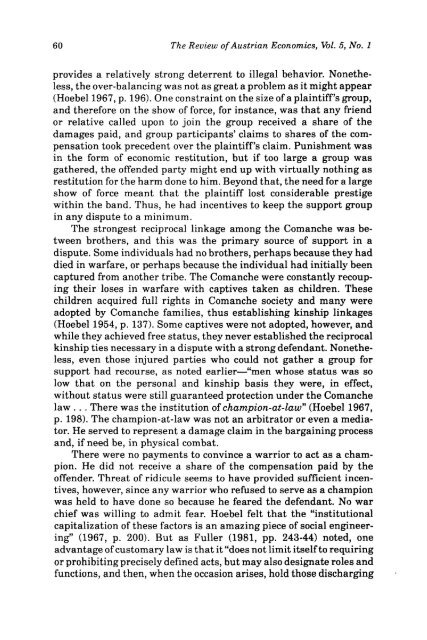Review of Austrian Economics - The Ludwig von Mises Institute
Review of Austrian Economics - The Ludwig von Mises Institute
Review of Austrian Economics - The Ludwig von Mises Institute
Create successful ePaper yourself
Turn your PDF publications into a flip-book with our unique Google optimized e-Paper software.
60 <strong>The</strong> <strong>Review</strong> <strong>of</strong> <strong>Austrian</strong> <strong>Economics</strong>, Vol. 5, No. 1<br />
provides a relatively strong deterrent to illegal behavior. Nonetheless,<br />
the over-balancing was not as great a problem as it might appear<br />
(Hoebel 1967, p. 196). One constraint on the size <strong>of</strong> a plaintiff's group,<br />
and therefore on the show <strong>of</strong> force, for instance, was that any friend<br />
or relative called upon to join the group received a share <strong>of</strong> the<br />
damages paid, and group participants' claims to shares <strong>of</strong> the compensation<br />
took precedent over the plaintiff's claim. Punishment was<br />
in the form <strong>of</strong> economic restitution, but if too large a group was<br />
gathered, the <strong>of</strong>fended party might end up with virtually nothing as<br />
restitution for the harm done to him. Beyond that, the need for a large<br />
show <strong>of</strong> force meant that the plaintiff lost considerable prestige<br />
within the band. Thus, he had incentives to keep the support group<br />
in any dispute to a minimum.<br />
<strong>The</strong> strongest reciprocal linkage among the Comanche was between<br />
brothers, and this was the primary source <strong>of</strong> support in a<br />
dispute. Some individuals had no brothers, perhaps because they had<br />
died in warfare, or perhaps because the individual had initially been<br />
captured from another tribe. <strong>The</strong> Comanche were constantly recouping<br />
their loses in warfare with captives taken as children. <strong>The</strong>se<br />
children acquired full rights in Comanche society and many were<br />
adopted by Comanche families, thus establishing kinship linkages<br />
(Hoebel 1954, p. 137). Some captives were not adopted, however, and<br />
while they achieved free status, they never established the reciprocal<br />
kinship ties necessary in a dispute with a strong defendant. Nonetheless,<br />
even those injured parties who could not gather a group for<br />
support had recourse, as noted earlier—"men whose status was so<br />
low that on the personal and kinship basis they were, in effect,<br />
without status were still guaranteed protection under the Comanche<br />
law . . . <strong>The</strong>re was the institution <strong>of</strong> champion-at-law" (Hoebel 1967,<br />
p. 198). <strong>The</strong> champion-at-law was not an arbitrator or even a mediator.<br />
He served to represent a damage claim in the bargaining process<br />
and, if need be, in physical combat.<br />
<strong>The</strong>re were no payments to convince a warrior to act as a champion.<br />
He did not receive a share <strong>of</strong> the compensation paid by the<br />
<strong>of</strong>fender. Threat <strong>of</strong> ridicule seems to have provided sufficient incentives,<br />
however, since any warrior who refused to serve as a champion<br />
was held to have done so because he feared the defendant. No war<br />
chief was willing to admit fear. Hoebel felt that the "institutional<br />
capitalization <strong>of</strong> these factors is an amazing piece <strong>of</strong> social engineering"<br />
(1967, p. 200). But as Fuller (1981, pp. 243-44) noted, one<br />
advantage <strong>of</strong> customary law is that it "does not limit itself to requiring<br />
or prohibiting precisely defined acts, but may also designate roles and<br />
functions, and then, when the occasion arises, hold those discharging

















